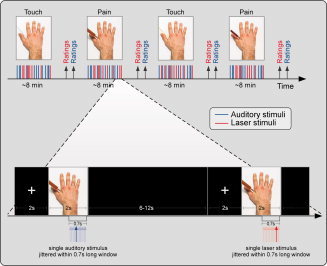Figure 1.

Experimental design. Event‐related potentials (ERPs) were collected in a single session and elicited by either nociceptive somatosensory stimuli delivered to the hand dorsum (in red) or by auditory stimuli delivered in the same area (in blue). ERPs were recorded in four observational blocks, whose order was counterbalanced across subjects. In each block, one of the two possible modulatory visual stimuli, representing either a painful stimulation (infliction of a syringe—Pain—in red) or a tactile stimulation (touch with a Q tip—Touch—in blue) of a model's hand, were presented. In each block, 15 laser and 15 auditory stimuli were delivered in pseudorandom order. Each trial started with a fixation cross presented for 2 s, followed by 2 s movie. After each block, subjects were asked to rate the intensity, saliency, and unpleasantness of both nociceptive and auditory sensation. This procedure allowed us to explore the possible modulation exerted by others' pain observation on the cortical responses elicited by nociceptive and auditory stimuli in the onlooker. [Color figure can be viewed in the online issue, which is available at wileyonlinelibrary.com.]
